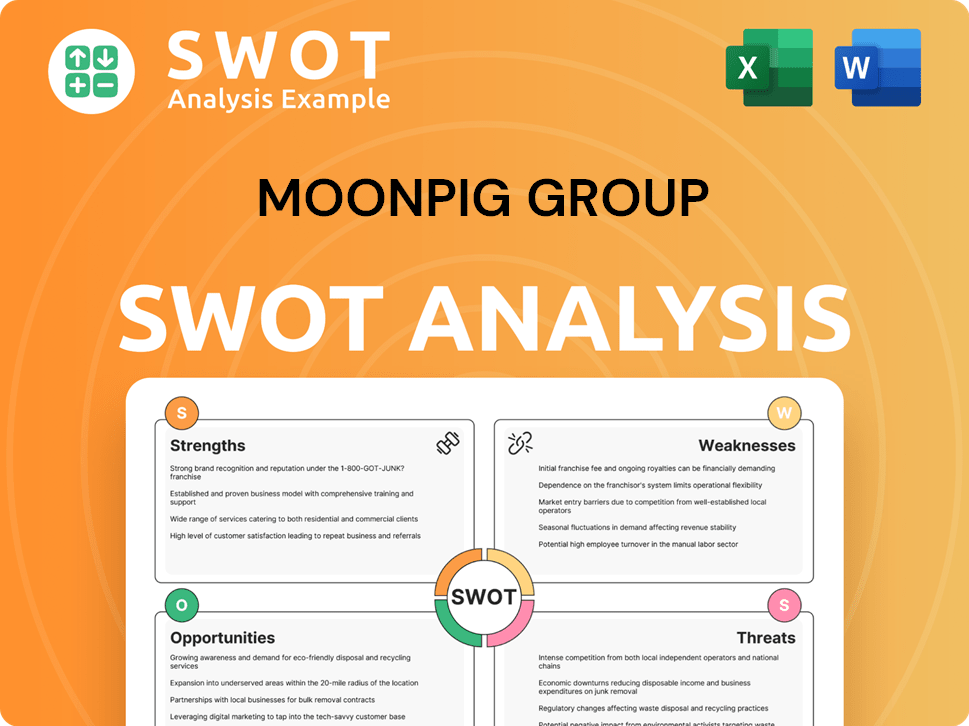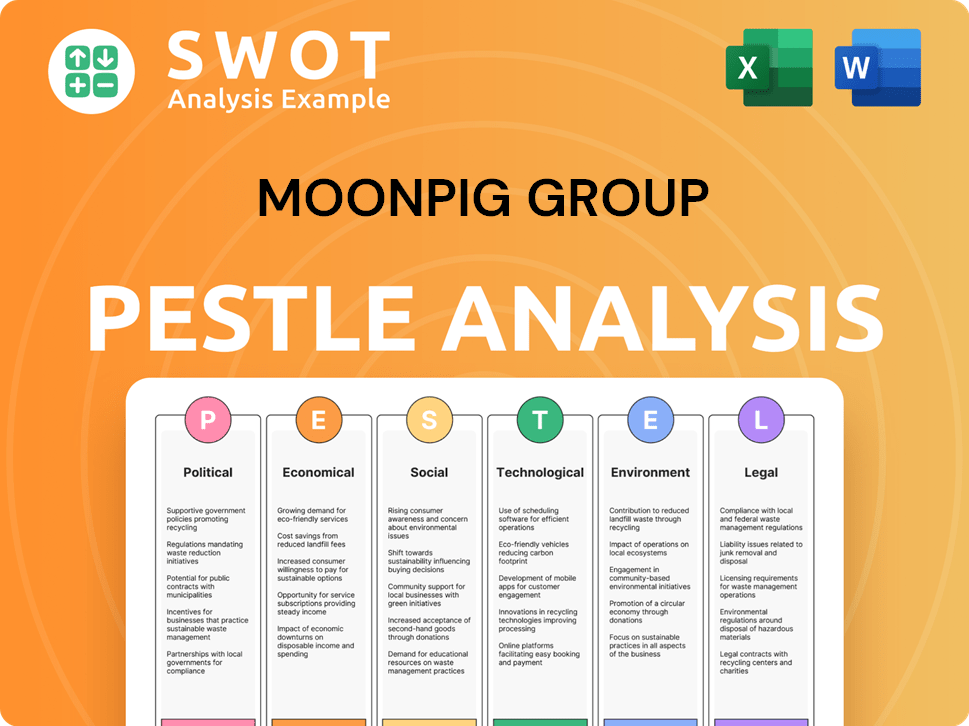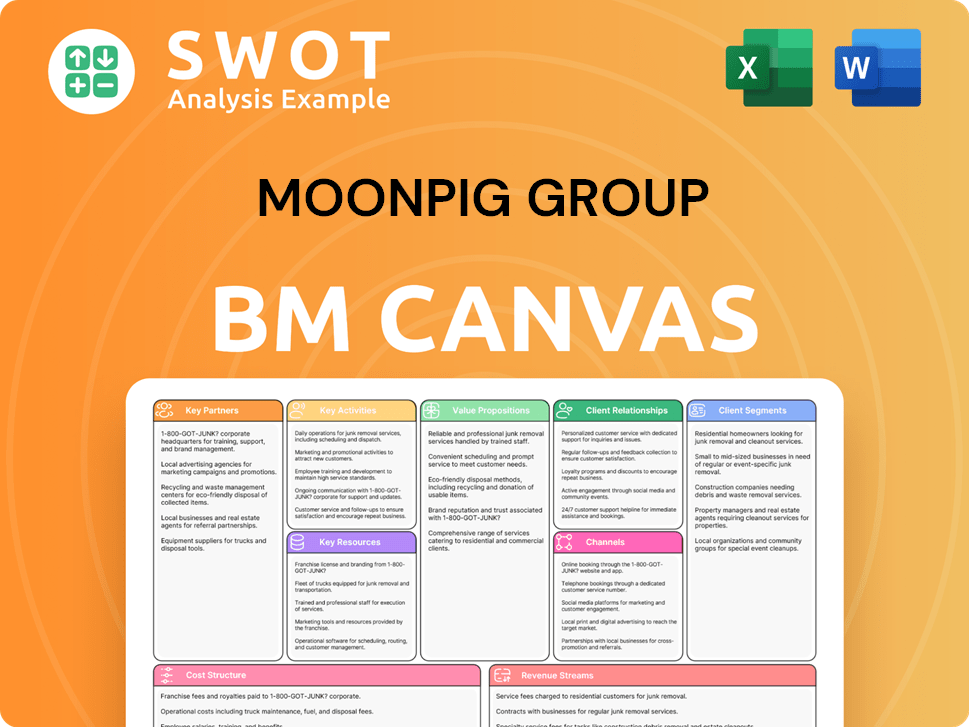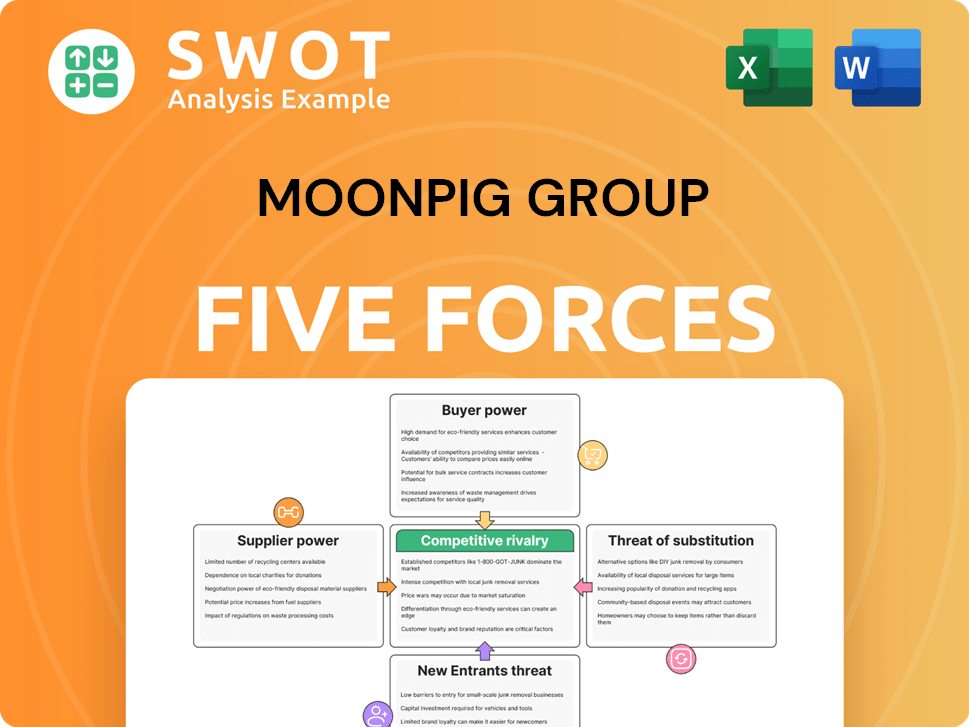Moonpig Group Bundle
How Does Moonpig Group Conquer the Digital Gifting Arena?
The online gifting market is booming, and Moonpig Group is at the forefront of this digital revolution. Founded in 2000, this company has transformed how we celebrate special occasions. This analysis dives deep into the Moonpig Group SWOT Analysis, exploring its market position and key rivals.

This exploration of the Moonpig competitive landscape provides a crucial understanding of the company's strategies. We'll dissect the Moonpig business model, assess its Moonpig market analysis, and compare it against its Moonpig competitors to reveal its unique advantages. Understanding the dynamics of online greeting cards and e-commerce gifting is essential for investors and strategists alike.
Where Does Moonpig Group’ Stand in the Current Market?
Moonpig Group operates primarily in the online personalized greeting card and gifting sector, with a strong focus on the UK and the Netherlands. The company's core business revolves around its flagship brands: Moonpig in the UK and Greetz in the Netherlands. These brands offer a wide array of personalized greeting cards, gifts, and flowers, catering to various occasions and customer preferences.
The value proposition of Moonpig Group lies in its ability to provide convenience and personalization. Customers can easily customize cards with photos and messages, and select from a curated range of gifts. This comprehensive offering, coupled with a user-friendly online platform, allows customers to conveniently purchase gifts for special occasions. The company's e-commerce model and digital marketing strategy ensure accessibility and a seamless shopping experience, contributing to its strong market position.
Moonpig holds a leading position in the UK's online greeting cards and gifts market. Its strong brand recognition and significant market share highlight its dominance in the digital gifting space. The company's focus on digital transformation has allowed it to adapt to changing consumer behaviors, particularly the increased preference for online shopping.
Moonpig Group's geographic presence is primarily concentrated in the UK and the Netherlands. These key European markets are where the company has established strong brand recognition and customer loyalty. This strategic focus allows the company to optimize its marketing efforts and tailor its offerings to specific regional preferences.
The company's product lines center around personalized offerings, allowing customers to customize cards with photos and messages. They also offer a curated selection of gifts like chocolates, balloons, and alcoholic beverages, alongside a growing flower delivery service. This diverse product range caters to a broad customer segment seeking convenience and personalization.
For the fiscal year ending April 30, 2024, Moonpig Group reported revenue of £322.3 million, demonstrating its scale within the industry. This consistent revenue generation underscores its leading role in its primary operating regions. This financial performance reflects the company's ability to capture a significant share of consumer spending on special occasions.
Moonpig's competitive advantages include a strong brand presence, a wide product range, and a focus on personalization. The company's digital platform and efficient supply chain contribute to its ability to meet customer demands effectively. Furthermore, the company's ability to adapt to changing consumer behaviors and preferences in the e-commerce gifting market has strengthened its position.
- Strong brand recognition in the UK and the Netherlands.
- Diverse product offerings, including cards, gifts, and flowers.
- User-friendly online platform and efficient order fulfillment.
- Focus on personalization and customer convenience.
To understand the full scope of the company's strategies, you can explore the Growth Strategy of Moonpig Group. This analysis provides insights into the company's expansion plans, digital marketing strategy, and future growth potential within the context of the Moonpig competitive landscape.
Moonpig Group SWOT Analysis
- Complete SWOT Breakdown
- Fully Customizable
- Editable in Excel & Word
- Professional Formatting
- Investor-Ready Format

Who Are the Main Competitors Challenging Moonpig Group?
Analyzing the Moonpig competitive landscape reveals a multifaceted market where the company faces direct and indirect competition across several sectors. This includes online personalized cards and gifts, e-commerce gifting, and flower delivery services. Understanding these competitive dynamics is crucial for assessing Moonpig's market share analysis and future growth potential.
Moonpig's business model centers on providing personalized greeting cards, gifts, and flowers through its online platform. Its revenue streams are primarily generated from the sale of these products, with additional income from delivery fees and add-on services. The company's customer acquisition strategies involve a strong digital marketing strategy and brand partnerships.
Direct competitors in the online personalized card and gift space include Funky Pigeon, Card Factory, and Thortful. These companies offer similar products and services, competing directly with Moonpig for customer attention.
Funky Pigeon, part of WHSmith, is a well-established online player. It offers a similar range of personalized cards and gifts. It leverages its connection to WHSmith's retail presence for brand visibility.
Card Factory, primarily a physical retailer, has expanded its online presence. It offers competitive pricing and a wide selection, challenging Moonpig on both value and convenience.
Thortful distinguishes itself by collaborating with independent designers. It offers a more unique and curated selection of cards that appeals to consumers looking for distinctive designs.
Moonpig also faces indirect competition from major online florists like Interflora and Bloom & Wild. General e-commerce giants like Amazon also pose an indirect threat.
E-commerce giants like Amazon offer a vast selection of gifts and can leverage their logistics networks for rapid delivery, posing a significant challenge. Retailers like Marks & Spencer and John Lewis also compete.
The competitive landscape is dynamic, with new players entering the market. These entrants often focus on specific product categories or curated selections. Competition involves battles over pricing, delivery speed, product innovation, and digital marketing. For a deeper dive into Moonpig's target audience analysis, consider exploring the Target Market of Moonpig Group.
Several factors drive competition in the online greeting card and gifting market. These include pricing strategies, delivery speed, product innovation, and effective digital marketing.
- Pricing: Competitive pricing is crucial for attracting customers.
- Delivery Speed: Fast and reliable delivery is a key differentiator.
- Product Innovation: Offering unique and personalized products.
- Digital Marketing: Effective use of digital channels to reach customers.
Moonpig Group PESTLE Analysis
- Covers All 6 PESTLE Categories
- No Research Needed – Save Hours of Work
- Built by Experts, Trusted by Consultants
- Instant Download, Ready to Use
- 100% Editable, Fully Customizable

What Gives Moonpig Group a Competitive Edge Over Its Rivals?
Understanding the Moonpig competitive landscape requires a deep dive into its strengths. The company has cultivated a robust brand over two decades, leading to high customer loyalty and strong brand recognition, especially in the UK. This established presence forms a significant barrier to entry for new competitors in the online greeting cards and e-commerce gifting market.
Moonpig's success is also driven by its advanced e-commerce platform and operational efficiency. This includes seamless personalization, efficient order processing, and reliable supply chain management. The company's ability to offer a wide range of products, from personalized cards to gifts and flowers, enhances convenience for customers and increases average order value. This one-stop-shop approach is a key element of its Moonpig business model.
Furthermore, Moonpig's competitive edge is enhanced by its data analytics capabilities. By understanding customer preferences, the company can personalize marketing efforts, driving engagement and repeat business. These advantages, combined with economies of scale in procurement and marketing, allow Moonpig to maintain competitive pricing while ensuring profitability. For more insights, explore the Growth Strategy of Moonpig Group.
Moonpig benefits from strong brand equity and customer loyalty. This is a result of its long-standing presence in the market. The company has invested heavily in building a trusted brand, which is crucial in a market driven by customer trust and repeat purchases.
Moonpig has invested in its e-commerce platform, which enables seamless personalization and efficient order processing. This technology allows for a streamlined customer experience, from design to delivery. The company's printing and fulfillment capabilities, often localized, contribute to faster turnaround times.
Moonpig's diversified product offering, including personalized cards, gifts, and flowers, provides a one-stop-shop solution. This broad range of products increases average order value and captures a larger share of celebratory spending. This approach enhances convenience and customer satisfaction.
Moonpig uses data analytics to understand customer preferences and personalize marketing efforts. This drives engagement and repeat business. By leveraging data, the company can offer targeted promotions and improve customer retention rates.
Moonpig's competitive advantages are multifaceted, contributing to its strong market position. These advantages include brand recognition, technological efficiency, product diversification, and data-driven customer personalization. These elements work together to create a sustainable competitive edge.
- Strong Brand Equity: High brand recall and customer loyalty built over two decades.
- Technological Infrastructure: Seamless personalization and efficient order processing.
- Product Range: One-stop-shop solution with personalized cards, gifts, and flowers.
- Data-Driven Marketing: Enhanced customer engagement and repeat business.
Moonpig Group Business Model Canvas
- Complete 9-Block Business Model Canvas
- Effortlessly Communicate Your Business Strategy
- Investor-Ready BMC Format
- 100% Editable and Customizable
- Clear and Structured Layout

What Industry Trends Are Reshaping Moonpig Group’s Competitive Landscape?
The Moonpig competitive landscape is shaped by the dynamic nature of the online greeting cards and e-commerce gifting industries. The company's position is influenced by evolving consumer behaviors, technological advancements, and the strategies of its competitors. A thorough Moonpig market analysis reveals both opportunities and challenges, which are crucial for its future growth. Understanding the Moonpig business model is key to assessing its ability to adapt and thrive.
The risks facing Moonpig include increased competition, fluctuating economic conditions, and the need to constantly innovate. The future outlook for Moonpig depends on its ability to navigate these challenges while capitalizing on emerging trends such as personalization and sustainability. The company's ability to maintain and expand its market share will be a key indicator of its success.
The industry is experiencing a significant shift towards e-commerce and mobile shopping. Personalization and customization are becoming increasingly important to consumers. Sustainability and ethical sourcing are also growing in importance.
Rising operational costs, especially in logistics and raw materials, pose a challenge. Increased competition from agile startups and established players is a constant threat. Economic uncertainties and fluctuating consumer spending could impact demand.
Expansion into new international markets with high e-commerce penetration is a key opportunity. Leveraging AI and machine learning to enhance personalization and optimize marketing is promising. Strategic partnerships with complementary businesses could create new revenue streams.
Moonpig benefits from its strong brand recognition and established customer base. Its focus on personalization and customization differentiates it from competitors. A well-developed digital platform and efficient supply chain also contribute to its competitive edge.
To maintain its competitive position, Moonpig should focus on several key strategies. These include expanding its product offerings and geographic reach. Improving customer experience through enhanced personalization and efficient delivery is also crucial.
- Enhance personalization through AI-driven recommendations.
- Expand into new international markets, particularly in regions with high e-commerce growth.
- Develop strategic partnerships with complementary businesses.
- Invest in sustainable sourcing and environmentally friendly practices.
Moonpig Group Porter's Five Forces Analysis
- Covers All 5 Competitive Forces in Detail
- Structured for Consultants, Students, and Founders
- 100% Editable in Microsoft Word & Excel
- Instant Digital Download – Use Immediately
- Compatible with Mac & PC – Fully Unlocked

Related Blogs
- What are Mission Vision & Core Values of Moonpig Group Company?
- What is Growth Strategy and Future Prospects of Moonpig Group Company?
- How Does Moonpig Group Company Work?
- What is Sales and Marketing Strategy of Moonpig Group Company?
- What is Brief History of Moonpig Group Company?
- Who Owns Moonpig Group Company?
- What is Customer Demographics and Target Market of Moonpig Group Company?
Disclaimer
All information, articles, and product details provided on this website are for general informational and educational purposes only. We do not claim any ownership over, nor do we intend to infringe upon, any trademarks, copyrights, logos, brand names, or other intellectual property mentioned or depicted on this site. Such intellectual property remains the property of its respective owners, and any references here are made solely for identification or informational purposes, without implying any affiliation, endorsement, or partnership.
We make no representations or warranties, express or implied, regarding the accuracy, completeness, or suitability of any content or products presented. Nothing on this website should be construed as legal, tax, investment, financial, medical, or other professional advice. In addition, no part of this site—including articles or product references—constitutes a solicitation, recommendation, endorsement, advertisement, or offer to buy or sell any securities, franchises, or other financial instruments, particularly in jurisdictions where such activity would be unlawful.
All content is of a general nature and may not address the specific circumstances of any individual or entity. It is not a substitute for professional advice or services. Any actions you take based on the information provided here are strictly at your own risk. You accept full responsibility for any decisions or outcomes arising from your use of this website and agree to release us from any liability in connection with your use of, or reliance upon, the content or products found herein.